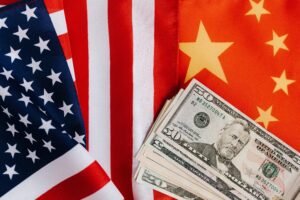“The Development and Dynamics of United States Foreign Policy: A Comprehensive Review of Historical Foundations, Geopolitical Considerations, and Contemporary Challenges”
TITLE:
“The Development and Dynamics of United States Foreign Policy: A Comprehensive Review of Historical Foundations, Geopolitical Considerations, and Contemporary Challenges”
ABSTRACT:
This complete survey delves into the multifaceted aspects of United States foreign policy, elucidating its foundations in historical, geopolitical, economic, and protection issues. The text goes via key pillars including countrywide security, economic interests, alliances, promotion of democracy and human rights, multilateralism, local attention, and edition to global modifications. The historical past reveals key intervals from isolationism to the Cold War and highlights shifts in global dynamics and US responses.
The synthesized literature assessment integrates various views, along with realism, idealism, and the impact of worldwide events on US foreign policy. The framework summarizes ancient foundations, theoretical views, Cold War legacies, publish-Cold War changes, safety paradigms, economic hobbies, and gentle electricity. This complete evaluation gives a nuanced knowledge of US global family members, summarizing its dynamic evolution, challenges, and contributions to the worldwide panorama.
KEYWORDS:
United States overseas coverage
Historical foundations
Geopolitical issues
Economic hobbies
National security
Alliances and Partnerships
Democracy and human rights
Multilateralism
Adaptation to international adjustments
The Legacy of the Cold War
INTRODUCTION:
United States foreign coverage is shaped by an aggregate of ancient, geopolitical, economic, and safety concerns.
Some key components include:
National Security:
Ensuring the safety and protection of the USA and its citizens is a top precedence. This consists of addressing traditional security threats together with army-demanding situations in addition to rising threats which include cyber-attacks and terrorism.
Economic hobbies: Another critical element is the protection and merchandising of US financial pursuits overseas. This includes alternate agreements, economic partnerships, and regulations designed to maintain a good global monetary environment for American companies.
Alliances and Partnerships: The US engages in diverse alliances and partnerships with special global places to bolster its geopolitical role and address commonplace challenges. Examples encompass NATO (North Atlantic Treaty Organization) and numerous bilateral alliances.
Support for democracy and human rights: Historically, America has sought to sell democratic values and human rights globally. This can include diplomatic efforts, monetary aid, and now and then navy interventions to help democratic actions or address human rights abuses
Multilateralism: The US participates in worldwide organizations and boards to deal with global troubles which consist of weather change, public fitness, and worldwide alternate. Multilateralism is visible as a way to construct consensus and resolve problems that require coordinated international efforts.
Regional consciousness: The US often has distinctive foreign coverage priorities in one-of-a-kind areas. For instance, its technique in Asia, the Middle East, Europe, and Latin America may range primarily based on nearby dynamics and US hobbies in each region.
Adapting to global changes: The worldwide surroundings are dynamic, and US foreign policy is adapting to new challenges and possibilities. This consists of addressing rising threats such as cyber war, navigating shifts in international energy dynamics, and responding to changes in technology and the worldwide economy.
HISTORICALLY BACKGROUND:
The historical past of US worldwide relations and overseas coverage is rich and complicated, fashioned through various factors along with geopolitical concerns, financial pursuits, and ideological principles. While it’s far beyond the scope of a brief answer to offer a complete review, right here are the important thing historical intervals and themes that have prompted US overseas policy:
Isolationism and the Early Republic (overdue 18th to early 19th century): In the early years of the USA, there has been a robust tendency toward isolationism. The nation sought to keep away from involvement in European conflicts, as evidenced by George Washington’s farewell deal. The Monroe Doctrine (1823) in addition recommended a coverage of non-interference in European affairs while cautioning in opposition to new colonization or interference within the Western Hemisphere.
Manifest Destiny and Enlargement (mid-nineteenth century): The idea of Manifest Destiny recommended westward expansion because the US received territory from Mexico and unfolded its impact throughout the continent. This duration laid the foundation for advancing US interests beyond its borders.
World Wars and emergence as a worldwide electricity (20th century): World War I marked a shift far away from isolationism because the US played a great role in warfare. After World War II, the USA became a superpower and contributed to the creation of global institutions such as the United Nations. The onset of the Cold War with the Soviet Union defined an awful lot of US foreign policy all through this era.
Cold War Period (1945-1991): The Cold War ruled US foreign coverage for most of the 20th century. The US and the Soviet Union engaged in a global ideological war that led to the creation of alliances (NATO) and local interventions (Korean War, Vietnam War). The coverage of containment sought to save you from the unfolding of communism.
Post-Cold War length (1991–2001): With the crumble of the Soviet Union, the USA entered a length of unipolarity. The attention shifted to selling democracy and free market capitalism. This generation became characterized by the aid of army interventions within the Balkans and humanitarian efforts in locations like Somalia. However, demanding situations consisting of terrorism and local conflicts endured.
The War on Terror and Sept. 11 (early twenty-first century): The terrorist attacks of September 11 marked a pivotal moment that brought about the announcement of the “War on Terror.” The goal of American interventions in Afghanistan and Iraq was to remove terrorist threats advert reshape regional dynamics. During this era, the priorities of US foreign policy have been reassessed.
Globalization and multilateralism (overdue 20th century – present): The past due twentieth century and early twenty-first century saw improved globalization, with America actively collaborating in international trade agreements. Efforts to deal with international challenges which include climate trade and pandemics have highlighted the significance of multilateral cooperation.
Shifts within the twenty-first century: The twenty-first century has seen shifts in US foreign policy, with converting administrations bringing exceptional procedures. Issues such as cyber safety, great strength competition (in particular with China), and rethinking alliances have come to be prominent topics.
The ancient development of US overseas coverage is marked by the anxiety among isolationism and engagement, as well as regular adaptation to rising global challenges. The role of the US in worldwide affairs has been dynamic, reflecting the changing geopolitical surroundings and the evolving countrywide expertise of its position within the international.
LITERATURE REVIEW:
Developing a literature evaluation and framework for US international relations and foreign coverage entails synthesizing qualitative statistics from numerous scholarly assets. Due to the complexity of the topic, it’s miles critical to draw on different factors of view. A literature assessment is synthesized, alongside a framework that carries qualitative facts.
Historical context: Much of the literature emphasizes the historical context shaping US foreign policy. Scholars which include Walter LaFeber and William Apple Guy Williams delve into how early US foreign family members had been encouraged through the preference for territorial enlargement, economic pursuits, and notions of appear destiny.
Realism vs. Idealism: The debate between realist and idealist perspectives in US overseas coverage is nicely documented. Realist scholars together with Hans Morgenthau argue that states act in their self-interest, even as idealists such as Woodrow Wilson emphasize the promotion of democracy and human rights. Qualitative evaluation highlights how these tensions have played out in policy selections over time.
Cold War Dynamics: The Cold War duration has been extensively studied. George Kennan’s idea of containment and the writings of scholars including John Lewis Gaddis provide a qualitative look at how the United States navigated global energy dynamics, alliances (NATO), and proxy conflicts for the duration of this period.
Post-Cold War Era: The published Cold War literature, especially from pupils inclusive of Francis Fukuyama, examines the role of America in a unipolar global. Qualitative information monitors a shift in the direction of liberal internationalism with an emphasis on democracy promoting, humanitarian intervention, and monetary globalization.
Globalization and economic hobbies: The works of Joseph Nye and Thomas Friedman contribute a qualitative take look at how economic concerns, globalization, and the upward push of firm agencies have formed US foreign policy. The literature underlines the interconnectedness of economic and geopolitical interests.
Security Paradigms: Qualitative studies via security students consisting of Barry Buzan and Ole Wæver have targeted evolving protection paradigms. The literature discusses how non-conventional threats consisting of terrorism, cyber security, and pandemics have affected US safety policy.
Identity and Soft Power: Drawing on the works of Joseph Nye and Samuel Huntington, the literature explores the role of identification and soft energy in US overseas policy. Qualitative statistics reveal how cultural international relations, public diplomacy, and the promotion of American values contribute to the kingdom’s global effect.
FRAMEWORK:
Based on the literature, a framework for US international members of the family and foreign coverage can be outlined:
Historical foundations:
Key Elements: Manifest Destiny, Territorial Expansion, and Early Diplomatic Principles.
A qualitative angle: Analysis of number one files, historic speeches, and diplomatic correspondence.
Theoretical perspectives:
Key elements: Realism, idealism, and balance between self-interest and values.
A qualitative component: An in-intensity exam of the writings of influential theorists and coverage makers.
Legacy of the Cold War:
Key elements: Containment, alliances, and proxy conflicts.
The Qualitative Aspect: Case Studies of Cold War Interventions and Diplomatic Exchanges.
Post-cold War Transformation:
Key factors: Liberal internationalism, democracy merchandising, and monetary globalization.
A qualitative perspective: Analysis of policy documents, presidential speeches, and diplomatic strategies.
Security paradigms inside the twenty-first century:
Key Elements: Non-Traditional Threats, Global Terrorism, and Cyber Security.
Qualitative perspective: Security strategy research, news reports, and professional analysis.
Economic pursuits and globalization:
Key elements: Trade agreements, monetary partnerships, and multinational organizations.
Qualitative issue: Analysis of financial policy, business dealings, and societal impact.
Soft strength and identification:
Key elements: Cultural international relations, public international relations, and the projection of American values.
The Qualitative Aspect: Exploring Cultural Exchanges, Public Outreach Programs, and Narratives in Diplomatic Engagement.
This framework integrates historical context, theoretical debates, and contemporary dynamics to offer a holistic understanding of global members of the family and US foreign coverage. Qualitative information drawn from professional literature enriches the evaluation and captures the nuances and complexities inherent in this subject matter.
FAQS of United States Foreign Policy:
Question: What are the key concepts that guide US overseas policy?
A: US overseas policy is guided using ideas consisting of ensuring country-wide security, shielding economic hobbies, promoting democracy and human rights, promoting alliances, undertaking multilateralism, and adapting to worldwide trade.
Question: How did the Cold War affect US overseas policy?
Answer: The Cold War considerably shaped US foreign policy, mainly in coverage of containment, the creation of alliances like NATO, and intervention in proxy conflicts around the sector. This also motivated America’s emphasis on the ideological war against communism.
Question: How does America balance realism and idealism in foreign policy?
A: US overseas coverage regularly acts in tension among realist ideas that prioritize country-wide hobbies and power and idealistic desires that emphasize selling democracy and human rights. Finding stability is essential to powerful international relations.
Question: What function does financial diplomacy play in US overseas policy?
Answer: Economic diplomacy is an integral part of US foreign policy, which includes trade agreements, monetary partnerships, and efforts to create a positive worldwide financial environment for American agencies. Economic issues are a key driving force in shaping diplomatic strategies.
Question: How has US overseas policy tailored to global adjustments within the 21st century?
Answer: The US has adapted to the demanding situations of the 21st century by addressing non-traditional threats which include cyber protection and terrorism, engaging in multilateral efforts to deal with international problems (e.G. Climate trade), and adapting strategies to cope with shifts in geopolitical dynamics.
Question: What is the significance of alliances in US foreign coverage?
A: Alliances play a key role in U.S. Overseas coverage by enhancing protection, sharing burdens, and improving diplomatic effect. Notable alliances include NATO, which emerged at some stage in the Cold War, and various bilateral partnerships that make contributions to nearby and worldwide balance.
CONCLUSIONS of United States overseas coverage:
A survey of United States foreign policy reveals a complex interaction of historic, geopolitical, economic, and security considerations. Key standards include ensuring country-wide security, shielding monetary interests, promoting democracy and human rights, alliances, multilateralism, and adapting to international exchange manual US diplomatic techniques
The historical overview huge durations, from isolationism to the Cold War and the cutting-edge challenges of the twenty-first century.
The literature evaluation suggests that US overseas coverage is deeply rooted in historical context, influenced using debates between realism and idealism, and shaped via principal activities inclusive of the Cold War.
The Cold War era noticed a shift closer to liberal internationalism and a focal point on democracy promotion. Globalization, economic pursuits, and evolving safety paradigms play an important position in shaping US overseas coverage, as evidenced by the work of students examining those dimensions.
The framework mentioned provides a structured lens through which to investigate US international relations, such as historical foundations, theoretical views, Cold War legacies, put-up-Cold War differences, twenty-first-century protection paradigms, monetary pastimes, and smooth electricity dynamics.
This holistic method underscores the nuanced and dynamic nature of US overseas coverage.
In the end, US overseas policy is a multifaceted and adaptive construct, fashioned by using historical legacies, theoretical debates, and present-day challenges. Integrating qualitative statistics from scholarly sources enriches our knowledge of the complexities inherent in this key issue of international relations.
REFERENCES:
LaFeber, W. (1994). The American Age: United States Foreign Policy at Home and Abroad Since 1750. Norton & Company.
Morgenthau, H.J. (1948). Politics among Nations: The Struggle for Power and Peace. Knob.
Kennan, G.F. (1947). “Sources of Soviet Behavior.” Foreign Affairs, 25(four), 566-582.
Nye, J.S. (2004). Soft Power: The Means to Success in World Politics. Public affairs.
Gaddis, J.L. (1986). The Containment Strategy: A Critical Appraisal of Postwar American National Security Policy. Oxford University Press.
Fukuyama, F. (1992). The cease of records and the closing guy. Free press.
Buzan, B., & Wæver, O. (2003). Regions and Powers: The Structure of International Security. Cambridge University Press.
Friedman, T.L. (2005). The World is Flat: A Brief History of the Twenty-first Century. Farrar, Straus and Giroux.
Huntington, S.P. (1996). The conflict of civilizations and the reshaping of the arena order. Simon & Schuster.
Williams, W.A. (1959). The tragedy of American diplomacy. Dell Publishers.
visit for more: Timebuissnesnews.com









